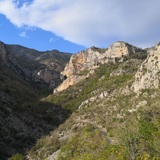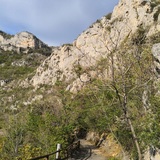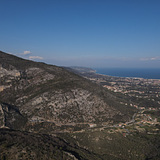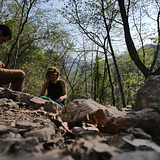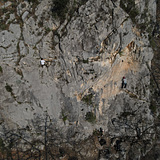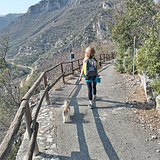☀️summer best season for: Grotte, Sasso del Rio, Legnaia, Placche Grigie, Placca dell' Artista, Litigometro, Placca Rosa, Cristalleria, Mac Carthy, Placca Pupillo, Grottino, Picco di Eolo, Groa, Cascata Pietrificata.
❄️winter best season for: Parco Giochi, Santa Lucia, Red Rock, Gumbi, Belvedere, Grotta dell'Ulivo, Cartoon, Spaziale, Paretone Orsi e Topi, Paretone, Bocca di Rosa, Cascata.
☀️sun during the day: mainly from 10-17
🌬️no wind: Legnaia, Placche Grigie, Paretone, Bocca di Rosa, Cascata Pietrificata.
👪 family friendly: Grotte, Parco Giochi, Santa Lucia, red Rock, Gumbi, Grotta dell'Ulivo, Cartoon, Sasso del Rio, Legnaia, Placche Grigie, Orsi e Topi, Cascata, Placca dell'Artista, Litigometro, Mc Carthy, Grottino, Groa
🇬🇧
The territory of Toirano is made up of calcareous-dolomitic rock with huge hills that can even reach 1000 meters above sea level, joined up to the plain of Borghetto by excavated hills with the presence of canyons created by the various small rivers which, once united, form the Varatella stream. all surrounded by the presence of various rock faces.
The crags in the Toiranese area include 500 climbing routes featuring different climbing styles, from tufas to erosions, from clean holds to cracks, from single pitches to multi-pitch, from third grade up to 8a+.
It can be climbed all year round, thanks to the climate and the different exposures of the cliffs surrounded by a fascinating nature just a few km from the seaside cities.
🇮🇹
Il territorio di Toirano è formato da roccia calcareo-dolomitica con enormi ammassi che possono arrivare anche a 1000 metri di altitudine, uniti fino alla pianura di Borghetto tramite colline scavate con presenza di canyon creati dai vari fiumiciattoli che una volta uniti formano il torrente Varatella, il tutto contornato dalla presenza di varie pareti rocciose.
Le falesie nel Toiranese comprendono 500 vie di arrampicata che presentano stili di arrampicata differenti, dalle canne alle erosioni, da prese nette a fessurine, da monotiri a multi-pich, dal terzo grado fino all'8a+.
Si può scalare tutto l'anno, grazie al clima e alle diverse esposizioni delle falesie circondati oltretutto da una natura affascinate a soli pochi km dalle città sul mare.
🇩🇪
Das Gebiet von Toirano besteht aus Kalkstein-Dolomitgestein mit riesigen Massen, die sogar 1000 Meter über dem Meeresspiegel erreichen können, verbunden mit der Ebene von Borghetto durch ausgegrabene Hügel mit dem Vorhandensein von Schluchten, die durch die verschiedenen kleinen Flüsse entstanden sind, die sich einst vereinigten , bilden den Bach Varatella und sind alle von verschiedenen Felswänden umgeben.
Die Felsen im Toiranese-Gebiet umfassen mehr als 500 Kletterrouten mit unterschiedlichen Kletterstilen, von Sinter bis Erosion, von sauberen Griffen bis zu Rissen, von Einseillängen bis Mehrseillängen, vom dritten Grad bis zu 8a+.
Er kann das ganze Jahr über bestiegen werden, dank des Klimas und der unterschiedlichen Expositionen der Klippen, umgeben von einer faszinierenden Natur, nur wenige Kilometer von den Küstenstädten entfernt.
🇬🇧
Climbing in Toirano dates back to the 1930s, in fact old pitons had been found in the 1960s.
The safest information, however, concerns the end of the 60s thanks to Aureli, Mattioli and Casini who open two routes in alpine style.
In the 80s we can instead find the first free-climbing routes.
In 1985 Mauro Curzio uses a battery drill to create the first hole and meets Luigi Minetto known as Gigio, with whom they open the first routes on the most comfortable wall in Toirano, the Palestrina. Then Gigio opens the first route on the walls of Groa, the Fessurina and in 1986 with the locals and other climbers they equip other routes alongside those already opened by Mauro Curzio.
The Zambarino brothers will also arrive in 1989, bolting other routes.
The 90s began in an excellent way even if the death of Mauro Curzio due to an accident put a stop to climbing in Toirano.
At the beginning of 2000 Toirano will be considered again and Fulvio Balbi opens a new sector (the Cascata) with different types of routes, unfortunately however there will be a stop again due to some species of birds that need tranquility to nest in some areas of the Toiranese. However, this situation makes it possible to re-appreciate the closest walls and thanks to Marco Zambarino and his cousin Emanuele Zambarino in 2003 they create the first resin route of Toirano and then with the help of the locals in 2005 the Climbers Toirano group is born who publish "Climbing between Basure and Fene" to help with the costs of the bolts.
Andrea Giorda and Manolo also arrive.
Years go by and in 2010 the Climbers Toirano, thanks to the help of "Sam" Samuele Meinero, transform themselves into the amateur sports association Climbers Toirano, creating events for the promotion of climbing such as the one for children in 2009 or the first boulder contest of the 2013.
🇮🇹
L'arrampicata a Toirano risale agli anni 30, erano infatti stati trovati vecchi chiodi negli anni '60.
Le notizie più sicure però riguardano la fine degli anni '60 grazie ad Aureli, Mattioli e Casini che aprono due vie in stile alpino.
Negli anni '80 possiamo invece trovare le prime vie in free-climbing.
Nel 1985 Mauro Curzio utilizza un trapano a batteria per creare il primo foro e incontra Luigi Minetto detto Gigio, con il quale aprono le prime vie sulla parete più comoda di Toirano, la Palestrina. Poi Gigio apre la prima via sulle pareti di Groa, la Fessurina e nel 1986 con i locals e altri arrampicatori attrezzano altre vie affianco a quelle già aperte da Mauro Curzio.
Arriveranno poi anche i fratelli Zambarino nel 1989 attrezzando altre vie.
Gli anni '90 iniziano in ottimo modo anche se poi la scomparsa di Mauro Curzio a causa di un incidente mette uno stop all'arrampicata a Toirano.
Agli inizi del 2000 Toirano verrà di nuovo considerata e Fulvio Balbi apre un nuovo settore (la Cascata) con diversi tipi di vie, purtroppo però ci sarà di nuovo uno stop a causa di alcune specie di uccelli che necessitano tranquillità per nidificare in alcune zone del Toiranese. Questa situazione permette però di riapprezzare le pareti più vicine e grazie a Marco Zambarino e il cugino Emanuele Zambarino nel 2003 creano la prima via resinata di Toirano e poi con l'aiuto dei locals nel 2005 nasce il gruppo Climbers Toirano che pubblicano "Arrampicare tra Basure e Fene" per aiutarsi con le spese delle chiodature.
Arrivano anche Andrea Giorda e Manolo.
Passano gli anni e i Climbers Toirano nel 2010, grazie all'aiuto di "Sam" Samuele Meinero, si trasformano in Associazione sportiva dilettantistica Climbers Toirano, creando manifestazioni per la promozione dell'arrampicata come quella per i bambini nel 2009 o il primo boulder contest del 2013.
🇩🇪
Das Klettern in Toirano geht auf die 1930er Jahre zurück, tatsächlich wurden alte Kletterhaken in den 1960er Jahren gefunden.
Die sichersten Informationen betreffen jedoch Ende der 60er Jahre dank Aureli, Mattioli und Casini, die zwei Routen im Alpinstil eröffnen.
In den 80er Jahren finden wir stattdessen die ersten Freikletterrouten.
1985 erstellt Mauro Curzio mit einem Akkubohrer das erste Loch und lernt Luigi Minetto, bekannt als Gigio, kennen, mit dem sie die ersten Routen an der bequemsten Wand in Toirano, der Palestrina, eröffnen. Dann eröffnet Gigio die erste Route an den Wänden von Groa, der Fessurina, und rüstet 1986 mit den Einheimischen und anderen Kletterern weitere Routen neben den bereits von Mauro Curzio eröffneten aus.
Die Zambarino-Brüder werden ebenfalls 1989 eintreffen und andere Routen bohren.
Die 90er begannen hervorragend, auch wenn der Unfalltod von Mauro Curzio dem Klettern in Toirano ein Ende setzte.
Anfang 2000 wird Toirano wieder in Betracht gezogen und Fulvio Balbi eröffnet einen neuen Sektor (die Cascata) mit verschiedenen Arten von Routen, aber leider wird es wieder einen Stopp geben wegen einiger Vogelarten, die Ruhe brauchen, um in einigen Gebieten zu nisten die Toiranese. Diese Situation ermöglicht es jedoch, die nächsten Wände neu zu schätzen, und dank Marco Zambarino und seinem Cousin Emanuele Zambarino im Jahr 2003 erstellen sie die erste Harzroute von Toirano und dann mit der Hilfe der Einheimischen im Jahr 2005 wird die Gruppe Climbers Toirano geboren die "Climbing between Basure and Fene" veröffentlichen, um bei den Kosten für die Bohrhaken zu helfen.
Auch Andrea Giorda und Manolo treffen ein.
Die Jahre vergehen und 2010 verwandeln sich die Climbers Toirano dank der Hilfe von "Sam" Samuele Meinero in den Amateursportverein Climbers Toirano und schaffen Veranstaltungen zur Förderung des Kletterns, wie die für Kinder im Jahr 2009 oder den ersten Boulder Wettbewerb 2013.
